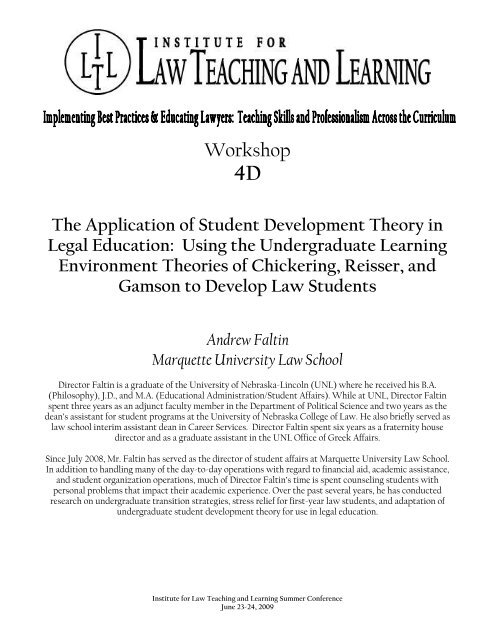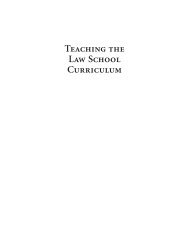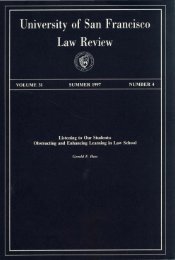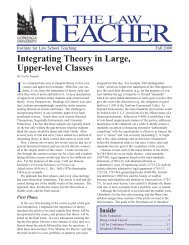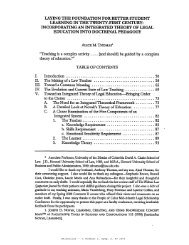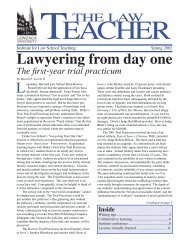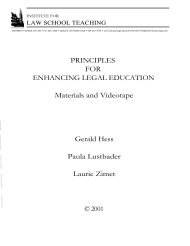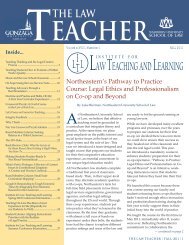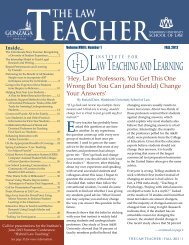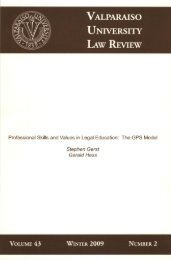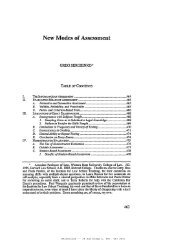The Application of Student Development Theory in Legal Education ...
The Application of Student Development Theory in Legal Education ...
The Application of Student Development Theory in Legal Education ...
Create successful ePaper yourself
Turn your PDF publications into a flip-book with our unique Google optimized e-Paper software.
Workshop<br />
4D<br />
<strong>The</strong> <strong>Application</strong> <strong>of</strong> <strong>Student</strong> <strong>Development</strong> <strong>The</strong>ory <strong>in</strong><br />
<strong>Legal</strong> <strong>Education</strong>: Us<strong>in</strong>g the Undergraduate Learn<strong>in</strong>g<br />
Environment <strong>The</strong>ories <strong>of</strong> Chicker<strong>in</strong>g, Reisser, and<br />
Gamson to Develop Law <strong>Student</strong>s<br />
Andrew Falt<strong>in</strong><br />
Marquette University Law School<br />
Director Falt<strong>in</strong> is a graduate <strong>of</strong> the University <strong>of</strong> Nebraska-L<strong>in</strong>coln (UNL) where he received his B.A.<br />
(Philosophy), J.D., and M.A. (<strong>Education</strong>al Adm<strong>in</strong>istration/<strong>Student</strong> Affairs). While at UNL, Director Falt<strong>in</strong><br />
spent three years as an adjunct faculty member <strong>in</strong> the Department <strong>of</strong> Political Science and two years as the<br />
dean‟s assistant for student programs at the University <strong>of</strong> Nebraska College <strong>of</strong> Law. He also briefly served as<br />
law school <strong>in</strong>terim assistant dean <strong>in</strong> Career Services. Director Falt<strong>in</strong> spent six years as a fraternity house<br />
director and as a graduate assistant <strong>in</strong> the UNL Office <strong>of</strong> Greek Affairs.<br />
S<strong>in</strong>ce July 2008, Mr. Falt<strong>in</strong> has served as the director <strong>of</strong> student affairs at Marquette University Law School.<br />
In addition to handl<strong>in</strong>g many <strong>of</strong> the day-to-day operations with regard to f<strong>in</strong>ancial aid, academic assistance,<br />
and student organization operations, much <strong>of</strong> Director Falt<strong>in</strong>‟s time is spent counsel<strong>in</strong>g students with<br />
personal problems that impact their academic experience. Over the past several years, he has conducted<br />
research on undergraduate transition strategies, stress relief for first-year law students, and adaptation <strong>of</strong><br />
undergraduate student development theory for use <strong>in</strong> legal education.<br />
Institute for Law Teach<strong>in</strong>g and Learn<strong>in</strong>g Summer Conference<br />
June 23-24, 2009
<strong>The</strong> <strong>Application</strong> <strong>of</strong> <strong>Student</strong> <strong>Development</strong><br />
<strong>The</strong>ory <strong>in</strong> <strong>Legal</strong> <strong>Education</strong>:<br />
Us<strong>in</strong>g the Undergraduate Learn<strong>in</strong>g<br />
Environment <strong>The</strong>ories <strong>of</strong> Chicker<strong>in</strong>g, Reisser,<br />
and Gamson to Develop Law <strong>Student</strong>s<br />
Institute for Law Teach<strong>in</strong>g & Learn<strong>in</strong>g<br />
Summer 2009 Conference, June 23, 2009<br />
Andrew Falt<strong>in</strong>, J.D., M.A, Director <strong>of</strong> <strong>Student</strong> Affairs<br />
Marquette University Law School
Introduction<br />
• <strong>Student</strong> <strong>Development</strong> <strong>The</strong>ory (SDT)<br />
• Millennial <strong>The</strong>ory v. Gen. NeXt <strong>The</strong>ory<br />
• Learn<strong>in</strong>g Environment <strong>The</strong>ory<br />
• <strong>Application</strong> to Today’s <strong>Legal</strong> <strong>Education</strong><br />
• Best Practices Discussion
Caveats<br />
1. Not a call for broad-based reform<br />
2. Not meant to be controversial<br />
3. Do not abandon your values!
<strong>Student</strong> <strong>Development</strong> <strong>The</strong>ory<br />
• Newer academic study<br />
• Explores cognitive and<br />
social student growth<br />
• Nevitt Sanford<br />
developed Challenge<br />
and Support.<br />
Challenge and Support<br />
=<br />
Quality Dissonance<br />
• Challenge requires<br />
proportional support.<br />
Evans, Forney, Guido-DiBrito, 1998, p. 7; Love and Guthrie, 1999, p. 88;<br />
Stage, Downey, and Dannells, 2000, p.18
Types <strong>of</strong> SDT<br />
• Psychosocial<br />
– How people identify themselves<br />
• Cognitive Structural<br />
– How people grow <strong>in</strong> their understand<strong>in</strong>g <strong>of</strong> the world<br />
• Typology<br />
– How people perceive/process the world<br />
• Person Environment<br />
– How social and physical environments shape people<br />
Evans et al., p. 12; Pascerella and Terenz<strong>in</strong>i, 2005, p. 33-35; Komives, Woodard, and Associates, p. 207-208
Howe and Strauss Millennial <strong>Student</strong><br />
• Positive view that students born around 1980 are:<br />
– Sheltered<br />
– In need <strong>of</strong> structure<br />
– Made to feel special<br />
– Motivated to achieve<br />
– Cooperative<br />
– Accept<strong>in</strong>g <strong>of</strong> differences<br />
– Reverent and respectful <strong>of</strong> adult authority<br />
– Not politically uniform <strong>in</strong>dividuals<br />
Howe and Strauss, 2003; Seider and Gardner, 2009
Howe and Strauss Millennial <strong>Student</strong><br />
• Work<strong>in</strong>g with Millennial <strong>Student</strong>s requires:<br />
– Provid<strong>in</strong>g structure and safety<br />
– Utiliz<strong>in</strong>g technology<br />
– Be<strong>in</strong>g mentors<br />
– Provid<strong>in</strong>g group activities <strong>in</strong> and out <strong>of</strong> class<br />
– Provid<strong>in</strong>g diverse achievement opportunities<br />
Howe and Strauss, 2003; Seider and Gardner, 2009
Taylor Generation NeXt <strong>The</strong>ory<br />
• More negative view that students born around 1980 are:<br />
– Needy<br />
– Lack<strong>in</strong>g <strong>in</strong> motivation<br />
– Not civil<br />
– More concerned about grad<strong>in</strong>g goals than learn<strong>in</strong>g<br />
– Consumer m<strong>in</strong>ded<br />
– Distrust<strong>in</strong>g <strong>of</strong> authority and established methods<br />
– Not politically uniform <strong>in</strong>dividuals<br />
– Unhappy with constructive criticism<br />
– Unable to enter the work place<br />
Taylor, 2006; Seider and Gardner, 2009
Taylor Generation NeXt <strong>The</strong>ory<br />
• Work<strong>in</strong>g with Gen. NeXt requires:<br />
Taylor, 2006<br />
– Articulat<strong>in</strong>g and re<strong>in</strong>forc<strong>in</strong>g expectations<br />
– Mak<strong>in</strong>g character a clear priority<br />
– Utiliz<strong>in</strong>g technology<br />
– Offer<strong>in</strong>g many <strong>in</strong>terpersonal opportunities
<strong>Application</strong> to <strong>Legal</strong> <strong>Education</strong><br />
• <strong>Development</strong> is variable and <strong>in</strong>complete.<br />
• SDT needs to address:<br />
–Academic rigor<br />
–Diverse students<br />
–A complex generation<br />
–Employer needs<br />
–Real solutions
Learn<strong>in</strong>g Environment <strong>The</strong>ory
Chicker<strong>in</strong>g, Reisser, and Gamson<br />
• Arthur W. Chicker<strong>in</strong>g, Pr<strong>of</strong>essor, George Mason<br />
University<br />
• L<strong>in</strong>da Reisser, Dean <strong>of</strong> <strong>Student</strong>s, Rockland<br />
Community College<br />
• Zelda Gamson, former Pr<strong>of</strong>essor, University <strong>of</strong><br />
Massachusetts
Chicker<strong>in</strong>g, Reisser, and Gamson<br />
• <strong>Education</strong> and Identity first published <strong>in</strong> 1969.<br />
• Chicker<strong>in</strong>g and Gamson wrote a 1987 article on<br />
undergraduate learn<strong>in</strong>g.<br />
• <strong>Education</strong> and Identity (2 nd ed.) released <strong>in</strong> 1993.
Learn<strong>in</strong>g Environment<br />
<strong>The</strong>ory Advantages<br />
1. <strong>Education</strong>al environments develop students<br />
<strong>in</strong> all areas (Chicker<strong>in</strong>g and Reisser, p. 265).<br />
2. Easy to implement and accept<br />
3. Applies to all generations
Learn<strong>in</strong>g Environment Components<br />
• Clear and Consistent Objectives<br />
• Good Institutional Size<br />
• <strong>Student</strong>/Faculty Relationships<br />
• Understandable Curriculum<br />
Chicker<strong>in</strong>g and Gamson, 1987; Chicker<strong>in</strong>g and Reisser, 1993, p. 265
Learn<strong>in</strong>g Environment Components<br />
• Quality Teach<strong>in</strong>g emphasiz<strong>in</strong>g:<br />
– Time on task<br />
– Communication <strong>of</strong> high expectations<br />
– Active learn<strong>in</strong>g<br />
– Respect for diverse learn<strong>in</strong>g methods<br />
– Prompt feedback<br />
• <strong>Student</strong> Friendships and Communities<br />
• <strong>Student</strong> <strong>Development</strong> Programs and Services<br />
Chicker<strong>in</strong>g and Gamson, 1987; Chicker<strong>in</strong>g and Reisser, 1993, p. 265
Clear and Consistent Objectives<br />
• “As <strong>in</strong>stitutional objectives rema<strong>in</strong> salient and are<br />
clearly expressed…a community <strong>of</strong> shared values…<br />
comes <strong>in</strong>to be<strong>in</strong>g” (Chicker<strong>in</strong>g and Reisser, p. 267).<br />
• Why is this necessary:<br />
1. Objectives set a uniform direction.<br />
2. <strong>Student</strong>s should challenge and discuss objectives.<br />
3. Value commitments, clearly conveyed, are more easily<br />
shared by students and faculty (Myers, 2008, p. 56).
Clear and Consistent Objectives<br />
• <strong>Application</strong> to <strong>Legal</strong> <strong>Education</strong>:<br />
– Does a mission drive discussions and strategies?<br />
– Are some objectives shared by most faculty?<br />
– Are goals, strategies, and challenges discussed?<br />
– Do mean<strong>in</strong>gful opportunities exist for students to<br />
challenge the school’s direction and objectives?
Good Institutional Size<br />
• “For as the number <strong>of</strong> persons outstrips the<br />
opportunities for significant participation and<br />
satisfaction, the developmental potential <strong>of</strong><br />
available sett<strong>in</strong>gs is attenuated for all” (Chicker<strong>in</strong>g<br />
and Reisser, p. 269).<br />
• Why is this necessary?<br />
1. Few activities and assistance reduces dissonance.<br />
2. Address<strong>in</strong>g student needs requires resources.
Good Institutional Size<br />
• <strong>Application</strong> to <strong>Legal</strong> <strong>Education</strong>:<br />
– What are students’ needs?<br />
– Can student concerns be acted on promptly?<br />
– Are there <strong>in</strong>tramural and writ<strong>in</strong>g opportunities<br />
available to all students?<br />
– Do all employees know their duties to students?
<strong>Student</strong>/Faculty Relationships<br />
• “With them, the actions and reactions learned dur<strong>in</strong>g<br />
childhood and habitual with parents or other authorities<br />
can be reexam<strong>in</strong>ed, and alternative behaviors can be<br />
tested” (Chicker<strong>in</strong>g and Reisser, p. 269).<br />
• Why is this necessary?<br />
1. Teach<strong>in</strong>g also happens out <strong>of</strong> class.<br />
2. Values and norms need to be transmitted.<br />
3. <strong>The</strong> more they work together, the more cognitive growth<br />
students experience (Myers, p. 57).
<strong>Student</strong>/Faculty Relationships<br />
• <strong>Application</strong> to <strong>Legal</strong> <strong>Education</strong>:<br />
– Is there a faculty advisor program? What is its role?<br />
– Are relationships discussed by faculty and students?<br />
– Are faculty members transmitt<strong>in</strong>g values to students?
Understandable Curriculum<br />
• “Curriculum, properly understood, <strong>in</strong>cludes the full range <strong>of</strong><br />
activities and <strong>in</strong>vestments that a student’s college<br />
experience comprises” (Chicker<strong>in</strong>g and Reisser, p. 269).<br />
• Why is this necessary?<br />
1. Discussions keep the curriculum current and relevant.<br />
2. <strong>Student</strong> understand<strong>in</strong>g will help fulfill personal goals.<br />
3. Courses and extracurriculars complement one another.
Understandable Curriculum<br />
• <strong>Application</strong> to <strong>Legal</strong> <strong>Education</strong>:<br />
– Do students know why courses are required?<br />
– Is student feedback on the curriculum solicited?<br />
– Do faculty know why/where their courses fit?<br />
– Do faculty expla<strong>in</strong> why/where their courses fit?
Teach<strong>in</strong>g<br />
• “When grades are based on <strong>in</strong>tegrat<strong>in</strong>g diverse materials<br />
and apply<strong>in</strong>g pr<strong>in</strong>ciples, students will try to develop such<br />
abilities” (Chicker<strong>in</strong>g and Reisser, p. 273).<br />
• What does good teach<strong>in</strong>g <strong>in</strong>clude?<br />
– Time on task<br />
– Communication <strong>of</strong> high expectations<br />
– Active learn<strong>in</strong>g<br />
– Respect for diverse learn<strong>in</strong>g methods and talents<br />
– Prompt feedback
• Why is this necessary?<br />
Teach<strong>in</strong>g<br />
1. <strong>Student</strong>s need to know what is wanted.<br />
2. <strong>Student</strong>s can be transformed.<br />
3. Study time has been dramatically reduced by<br />
real and perceived pressures (Fried, 2006, p. 3).
Teach<strong>in</strong>g<br />
• <strong>Application</strong> to <strong>Legal</strong> <strong>Education</strong>:<br />
– Do students know that there are high<br />
expectations and what that means?<br />
– Is more material assigned than is covered?<br />
– Is material current, relevant, or put <strong>in</strong> context?
<strong>Student</strong> Friendships and Communities<br />
• “<strong>The</strong> personal connections developed dur<strong>in</strong>g<br />
college can have lifelong ramifications… students<br />
<strong>of</strong>ten learn more from each other than from<br />
teachers” (Chicker<strong>in</strong>g and Reisser, p. 275).<br />
• Why is this necessary?<br />
1. Pr<strong>of</strong>essional relationships must start early.<br />
2. Empathiz<strong>in</strong>g and listen<strong>in</strong>g can be enhanced.
<strong>Student</strong> Friendships and Communities<br />
• <strong>Application</strong> to <strong>Legal</strong> <strong>Education</strong>:<br />
– Are group activities encouraged?<br />
– Do some activities <strong>in</strong>clude friends and family?<br />
– Are students taught how to study together?<br />
– Are barriers to group formation discussed?
<strong>Development</strong> Programs and Services<br />
• “Us<strong>in</strong>g student development concepts to<br />
evaluate everyth<strong>in</strong>g done outside the classroom<br />
can facilitate both large and small changes.<br />
Together, they add up to a lively, <strong>in</strong>vit<strong>in</strong>g,<br />
stimulat<strong>in</strong>g, friendly place that fosters student<br />
success” (Chicker<strong>in</strong>g and Reisser, p. 279).<br />
• Why is this necessary?<br />
1. SDT provides a vehicle to analyze programs.<br />
2. Humans are constantly develop<strong>in</strong>g.<br />
3. Programs m<strong>in</strong>dful <strong>of</strong> SDT can fill gaps.
<strong>Development</strong> Programs and Services<br />
• <strong>Application</strong> to <strong>Legal</strong> <strong>Education</strong>:<br />
– Does the law school exam<strong>in</strong>e the services <strong>of</strong>fered?<br />
– Do faculty encourage students to utilize services?<br />
– Are students asked what they need and want?<br />
– Do you know what others are do<strong>in</strong>g?
Millennial v. Gen. NeXt<br />
Millennial Relevance<br />
1. Programs and relationships help students feel<br />
special/protected.<br />
2. Objectives and curriculum create structure.<br />
3. <strong>Student</strong>s love work<strong>in</strong>g <strong>in</strong> diverse groups.<br />
4. Mentor<strong>in</strong>g improves transition to the workplace<br />
(Beard, Schwieger, and Surendran, 2008, p. 104).
Millennial v. Gen. NeXt<br />
Gen. NeXt Relevance<br />
1. <strong>Student</strong>s expect/need services.<br />
2. <strong>Student</strong>s need lessons <strong>in</strong> character/civility.<br />
3. Challenges to mission and curriculum provide<br />
constructive challenges to authority.<br />
4. Assign<strong>in</strong>g work not covered lowers motivation.<br />
5. <strong>Student</strong>s are “ends focused”.
Conclusions<br />
1. Individuals are constantly develop<strong>in</strong>g.<br />
2. SDT can be applied to legal education.<br />
3. Quality learn<strong>in</strong>g environments help<br />
develop all students.
Take Away Po<strong>in</strong>ts<br />
1. Discuss your mission and how it guides the school.<br />
2. Consistently reiterate that top effort is expected.<br />
3. State <strong>of</strong>ten what is appropriate/expected behavior.<br />
4. Ensure everyone understands the curriculum and how<br />
other activities complement it.<br />
5. Ensure everyone understands available services.
References<br />
Beard, D., Schwieger, D., & Surendran, D. (2008). Prepar<strong>in</strong>g the Millennial Generation for the Work Place: How can Academia Help? Proceed<strong>in</strong>gs <strong>of</strong> the 2008 ACM<br />
SIGMIS CPR Conference on Computer Personnel Doctoral Consortium and Research, 102-105.<br />
Chicker<strong>in</strong>g, A.W. & Gamson, Z.F. (1987). Seven Pr<strong>in</strong>ciples for Good Practice <strong>in</strong> Undergraduate <strong>Education</strong>. AAHE Bullet<strong>in</strong>, March 1987, 3-7.<br />
Chicker<strong>in</strong>g, A.W. & Reisser, L. (1993). <strong>Education</strong> and Identity (2nd ed.). San Francisco: Jossey -Bass.<br />
Evans, N.J., Forney, D.S., & Guido-DiBrito, F. (1998). <strong>Student</strong> <strong>Development</strong> <strong>in</strong> College: <strong>The</strong>ory, Research, and Practice. San Francisco: Jossey-Bass.<br />
Howe, N. & Strauss, W. (2003). Millennials Go To College. New York: Life Course.<br />
Keel<strong>in</strong>g, R.P. (2006). Learn<strong>in</strong>g Reconsidered 2: Implement<strong>in</strong>g Campus-Wide Focus on the <strong>Student</strong> Experience. Wash<strong>in</strong>gton, D.C.: NASPA.<br />
Komives, S.R. & Woodard, D. (2003). <strong>Student</strong> Services: A Handbook for the Pr<strong>of</strong>ession (4th ed.). San Francisco: Jossey-Bass.<br />
Love, P.G. & Guthrie, V.L. (1999). Understand<strong>in</strong>g And Apply<strong>in</strong>g Cognitive <strong>Development</strong> <strong>The</strong>ory: New Directions For <strong>Student</strong> Services. San Francisco: Jossey-Bass.<br />
Monaco, M. & Mart<strong>in</strong>, M. (2007). <strong>The</strong> Millennial <strong>Student</strong>: A New Generation <strong>of</strong> Learners. Athletic Tra<strong>in</strong><strong>in</strong>g <strong>Education</strong> Journal, 2(Apr-Jun), 42-46.<br />
Myers, C.B. (2008). Divergence <strong>in</strong> Learn<strong>in</strong>g Goal Priorities Between College <strong>Student</strong>s and <strong>The</strong>ir Faculty: Implication for Teach<strong>in</strong>g and Learn<strong>in</strong>g. College Teach<strong>in</strong>g, 56(1),<br />
53-58.<br />
Obl<strong>in</strong>ger, D. (2003). Boomers, Gen-Xers, & Millennials: Understand<strong>in</strong>g the New <strong>Student</strong>s. EDUCASEreview, 38(4), 36-40.<br />
Pascarella, E.T. & Terenz<strong>in</strong>i, P.T. (2005). How College Affects <strong>Student</strong>s: A Third Decade <strong>of</strong> Research (Volume 2). Indianapolis: Jossey-Bass.<br />
Seider, S. & Gardner, H. (April, 2009). <strong>The</strong> Fragmented Generation. Journal <strong>of</strong> College and Character, X(4), 1-3.<br />
Stage, F.K. & Dannells, M. (Eds.).(2000). L<strong>in</strong>k<strong>in</strong>g <strong>The</strong>ory to Practice: Case Studies for Work<strong>in</strong>g with College <strong>Student</strong>s (2nd ed.). New York: Brunner-Routledge.<br />
Taylor, M.L. (2006). Generation NeXt Comes to College: 2006 Updates and Emerg<strong>in</strong>g Issues. A Collection <strong>of</strong> Papers on Self-Study and Institutional Improvement, Volume<br />
2, Chapter 2, 48-55.
What works for you?<br />
• Develop<strong>in</strong>g and convey<strong>in</strong>g a mission<br />
• Model<strong>in</strong>g and expla<strong>in</strong><strong>in</strong>g appropriate conduct<br />
• Enforc<strong>in</strong>g high standards<br />
• Develop<strong>in</strong>g and expla<strong>in</strong><strong>in</strong>g your curriculum<br />
• Develop<strong>in</strong>g faculty/student relationships<br />
• Assess<strong>in</strong>g student needs <strong>in</strong> design<strong>in</strong>g services


